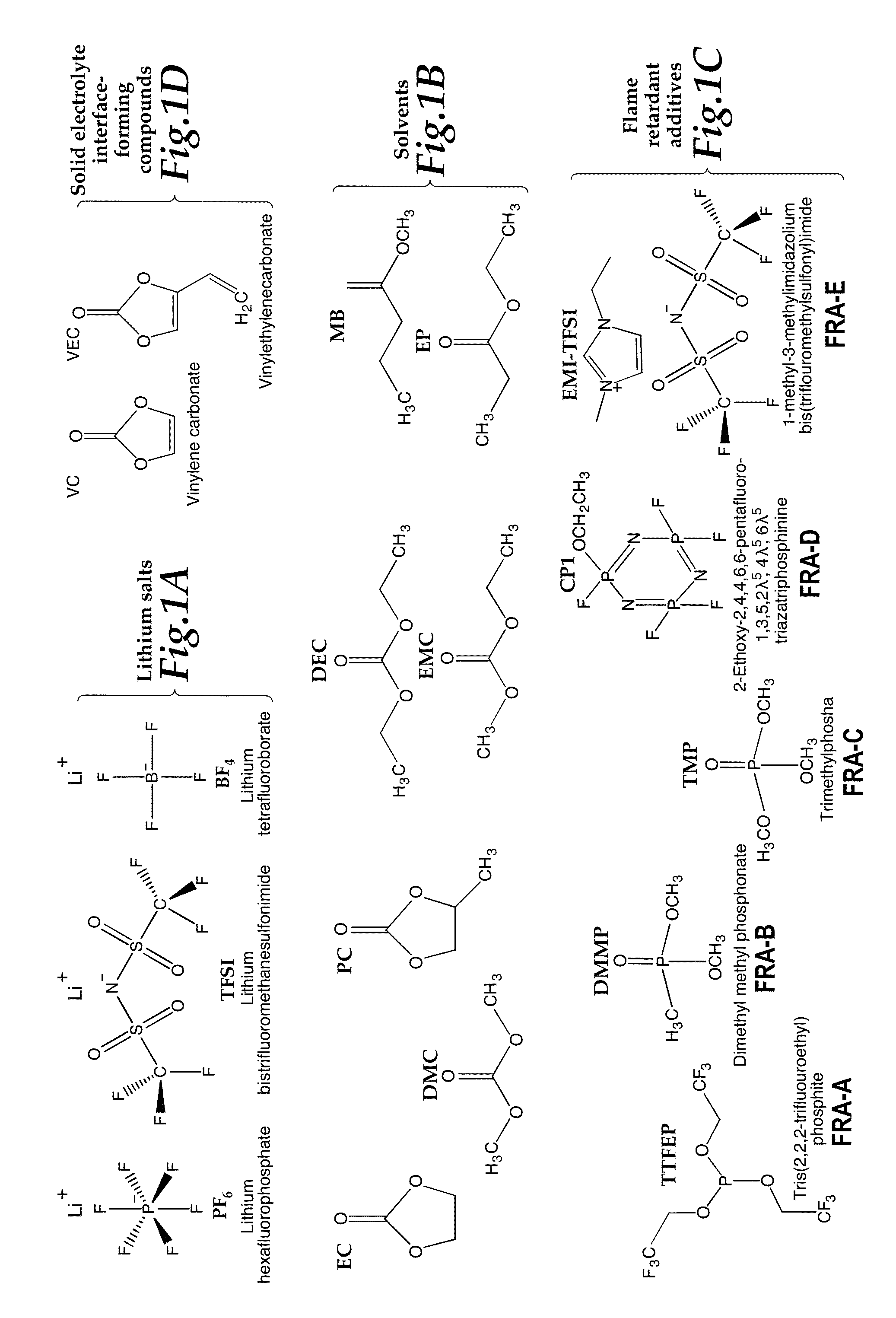Electrolyte for Electrochemical Energy Storage Devices
a technology electrochemical energy, applied in the field can solve the problems of reducing flammability and negatively affecting performance, and achieve the effects of improving the safety of electrochemical energy storage devices, improving flammability profiles in electrolytes, and high performan
- Summary
- Abstract
- Description
- Claims
- Application Information
AI Technical Summary
Benefits of technology
Problems solved by technology
Method used
Image
Examples
example i
[0044]Electrolytes were prepared in an inert atmosphere (Argon) glovebox by combining salts, solvents, co-solvents, and additives. Compounds were obtained from chemical manufacturers or suppliers. Specific compositions prepared are shown in Table 2. The structures of selected electrolyte components grouped as classes of compounds are shown in Table 2. The structures of selected electrolyte components grouped as classes of compounds are shown in FIGS. 1A, 1B, 1C, and 1D. The compound names and their abbreviations are listed as follows:
Salts
[0045]Lithium hexafluorophosphate (LiPF6)
Lithium bistrifluoromethanesulfonimide (LiTFSI)
Lithium tetrafluoroborate (LiBF4)
Solvents / Co-Solvents
[0047]Diethyl carbonate (DEC)
[0048]Dimethyl carbonate (DMC)
[0049]Ethyl methyl carbonate (EMC)
[0050]Ethyl Propionate (EP)
[0051]Methyl Butyrate (MB)
Flame Retardant Compounds
[0052]Tris(2,2,2-trifluoroethyl)phosphate (TTFEP) (FRA-A)
[0053]Dimethyl methylphosphonate (DMMP) (FRA-B)
[0054]T...
example ii
[0065]Electrolyte flammability was measured using multiple methods including “wick tests”, flash point tests, and oxygen calorimetry tests. For the wick tests, a ˜1.5 inch piece of glass fiber tape saturated with 1 mL of the electrolyte. The saturated glass fiber tape was suspended above an alcohol burner (using denatured ethanol as the fuel) to a position in which the tip of the flame contacted the mid-point of the glass fiber tape. The flame height and burn time were recorded. Two to five trials were performed for each electrolyte, and trials were recorded with video. Averages of initial burn time and initial flame height were calculated. The mass normalized self-extinguishing time was determined from the mass and burn time. To determine flash points of electrolytes, samples were tested by Galbraith Laboratories using ASTM D56 and D93 methods. For electrolytes with flash points expected to be below 80° C., the ASTM D56 (Tag Closed Cup) test was performed. For electrolytes with fla...
example iii
[0073]The ionic conductivity for the electrolytes was evaluated in order to determine the performance of the electrolyte over wide temperature ranges. To measure conductivity, a Mettler-Toledo InLab 710 conductivity cell with an in-house fabricated air-tight holder was used. The cell was assembled in an inert atmosphere glovebox and then sealed completely before removal for measurements. The air-tight holder for the conductivity was fabricated to provide an air-tight seal and prevent exposure of the electrolytes to ambient humidity during the conductivity testing. Once removed, the cell was placed inside a Cincinnati Sub-Zero Microclimate 1.2 benchtop environmental chamber. The conductivity probe was connected to an Agilent 4338B Milliohmmeter for measuring resistance. Conductivity was determined from dividing the provided cell constant (0.8 cm−1) by the measured resistance.
[0074]The ionic conductivity of selected electrolytes was evaluated in comparison with baselines over a wide t...
PUM
| Property | Measurement | Unit |
|---|---|---|
| freezing point | aaaaa | aaaaa |
| freezing point | aaaaa | aaaaa |
| boiling point | aaaaa | aaaaa |
Abstract
Description
Claims
Application Information
 Login to View More
Login to View More - R&D
- Intellectual Property
- Life Sciences
- Materials
- Tech Scout
- Unparalleled Data Quality
- Higher Quality Content
- 60% Fewer Hallucinations
Browse by: Latest US Patents, China's latest patents, Technical Efficacy Thesaurus, Application Domain, Technology Topic, Popular Technical Reports.
© 2025 PatSnap. All rights reserved.Legal|Privacy policy|Modern Slavery Act Transparency Statement|Sitemap|About US| Contact US: help@patsnap.com



